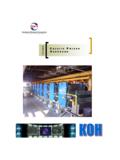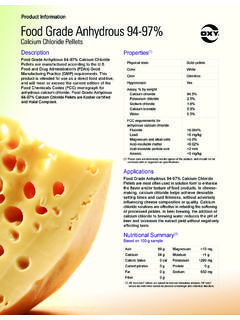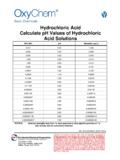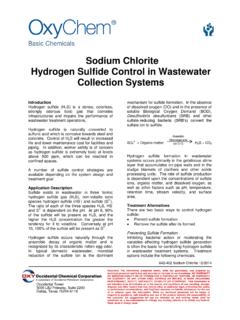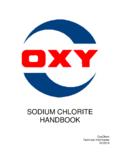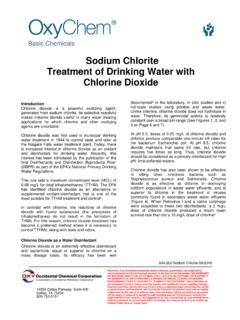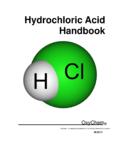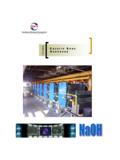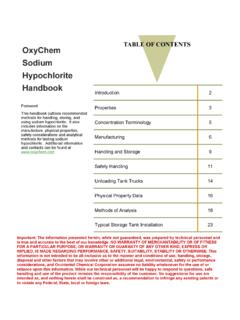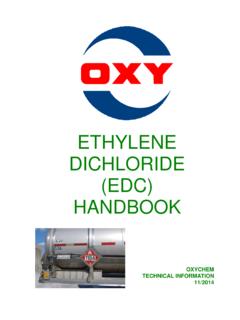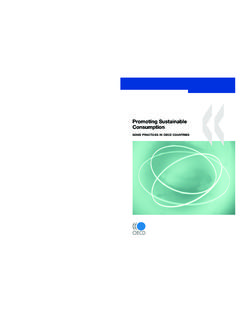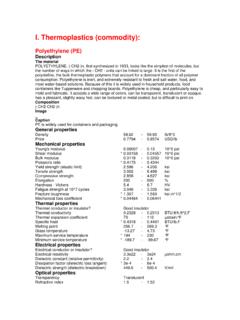Transcription of Vinyl Chloride Monomer - Occidental Petroleum
1 Product Stewardship Summary Vinyl Chloride Monomer Summary Vinyl Chloride Monomer (VCM) is a colorless, flammable gas at room temperature. Its chemical formula is C2H3Cl. It is primarily used to manufacture polyvinyl Chloride (PVC), a very stable, non-flammable, lightweight and durable plastic. PVC is used in a variety of applications. For example, it is found in common building products such as PVC pipe and window frames. 1. Chemical Identity Name: Vinyl Chloride Monomer Synonyms: VCM, Vinyl Chloride , Chloroethene, Chloroethylene Chemical Abstracts Service (CAS) number: 75-01-4. Chemical Formula: C2H3Cl Molecular Weight: Vinyl Chloride Monomer (VCM) is a colorless, flammable gas at room temperature.
2 At concentrations of about percent VCM in air, VCM can be an explosion hazard. VCM is often stored as a liquid under pressure. The liquid evaporates readily at ambient temperatures. At high concentrations, it has a sweet odor typical of chlorinated hydrocarbons. VCM vapors are heavier than air and tend to sink to low areas. 2. Production VCM is manufactured using a series of chemical reactions. The initial feedstocks are ethylene and chlorine. Ethylene is made by processing natural gas or Petroleum . Chlorine is derived from brine. The first reaction steps produce ethylene dichloride (EDC). EDC is manufactured by OxyChem by two different reactions.
3 Direct chlorination is the reaction of ethylene and chlorine: C2H4 + Cl2 C2H4Cl2. Oxychlorination is the reaction of oxygen, ethylene and hydrogen Chloride : O2 + C2H4 + 2 HCl C2H4Cl2 + H2O. The next reaction occurs when the temperature and pressure of EDC is raised. The EDC molecule is cracked to produce VCM and hydrogen Chloride . The reaction is: C2H4Cl2 C2H3Cl + HCl Page 1 of 6. The following is a schematic of the process: OxyChem is a leading manufacturer of VCM and operates facilities in Deer Park, Texas; Ingleside, Texas; and LaPorte, Texas. 3. Uses OxyChem does not sell VCM to household consumers. VCM is used primarily as a raw material in industrial operations that manufacture polyvinyl Chloride (PVC).
4 The polyvinyl Chloride , in turn, is used in products such as: Building materials siding, roofing, water distribution, irrigation, sewer and sprinkler pipe, fencing; wire and cable insulation; electrical conduit; floor and wall coverings, window frames, gutters and downspouts Industrial processes - landfill liners, piping used in food processing, chemical processing and other manufacturing Medical devices - for blood and intravenous bags, kidney dialysis and blood transfusions, cardiac catheters, endotracheal tubes, artificial heart valves and many others Automotive components - for body side moldings, interior upholstery, under-the hood wiring, under-the-car abrasion coatings, floor mats, dashboards and arm rests Electronics components in air conditioners, floppy disks, components, housings, keyboards, phone systems, computers, power tools.
5 Electrical cords, refrigerators, fiber optics, washers Toys - for rigid and flexible parts Packaging materials - for flexible food wrap, shrink wrap, jar lids and can linings; and for rigid blister and clamshell packaging, and bottles to store household , personal care products, and automotive lubricants VCM is consumed and converted into PVC during the manufacture of PVC resin. OxyChem's industrial customers further process PVC resin to manufacture finished articles. Page 2 of 6. 4. Physical and Chemical Properties Flammability VCM is extremely flammable. At concentrations of about percent VCM in air, VCM can be an explosion hazard. Direct contact with open flames or a high energy heat source will result in combustion and corrosive, noxious gases.
6 If combustion occurs, extinguish fires using dry chemical, foam, or carbon dioxide. Water may be ineffective, but should be used to keep fire-exposed containers cool. Reactivity VCM will polymerize if exposed to air, elevated temperatures or other activating substances. Inhibitors are often added to VCM to prevent polymerization during storage. VCM can be stored in vessels made of common materials of construction. VCM is stable with common metals other than aluminum and aluminum alloys and copper and copper alloys (including brass). When moisture is present, VCM can corrode iron and steel. Avoid VCM contact with moisture, pure oxygen, strong alkalis, alkali metals, open flames and welding arcs, and other high temperature sources, which induce thermal decomposition to irritating and corrosive hydrochloric acid.
7 5. Health Effects Inhalation Several minutes of exposure to high, but attainable concentrations (over 1000 ppm) may cause central nervous system depression with effects such as dizziness, drowsiness, disorientation, tingling, numbness or burning sensation of the hands and feet, impaired vision, nausea, headache, difficulty breathing, cardiac arrhythmias, unconsciousness, or even death. Eye and Skin Contact Contact with rapidly evaporating liquid VCM can cause frostbite. Ingestion Ingestion is not a likely route of exposure because VCM is a vapor at normal temperature. Chronic effects VCM is a known human carcinogen. Occupational overexposure has produced a specific cancer (angiosarcoma of the liver) and is associated with hepatocellular and cholangiocellular cancer.
8 Occupational exposure has also resulted in changes in bones and skin, especially in the extremities such as the fingers (acroosteolysis). Additionally, repeated exposure may result in dose-related sensory disorders, nervous system effects, blood system damage, lymphatic system changes, liver malfunction, pulmonary insufficiency, and dermatitis. Developmental/Reproductive Studies VCM did not cause birth defects when tested in rats, mice, or rabbits. Studies in rats show that inhalation produces fetal toxicity only at exposure levels that also produce maternal toxicity. 6. Environmental Effects If released to soil, VCM is expected to have high mobility.
9 Volatilization from moist soil surfaces is expected to be an important fate process based on its vapor pressure. If VCM is released into water, it is not expected to adsorb to suspended solids and sediment in the water. The biodegradation half-life of Vinyl Chloride in aerobic and anaerobic waters was reported as 28 and 110. Page 3 of 6. days, respectively. Volatilization from water surfaces is expected to be an important fate process. The estimated volatilization half-lives for a model river and model lake are 1 hour and 3 days, respectively. VCM is practically non-toxic to fish on an acute basis. If released to air, VCM will exist solely as a gas in the ambient atmosphere.
10 It will be degraded in the atmosphere by reaction with photochemically-produced hydroxyl radicals; the half-life for this reaction in air is estimated to be 55 hours. 7. Exposure The most likely ways exposures could occur are: Worker exposure Exposure could occur in the manufacturing facility or in industrial facilities that use VCM. Exposures could occur by inhalation of vapors or by contact to the skin or eye. VCM is used in closed systems in manufacturing processes to minimize exposures. In the , the Occupational Safety and Health Administration regulates VCM. The standard is in 29 CFR It contains requirements for personal protective equipment, medical surveillance, and training.
